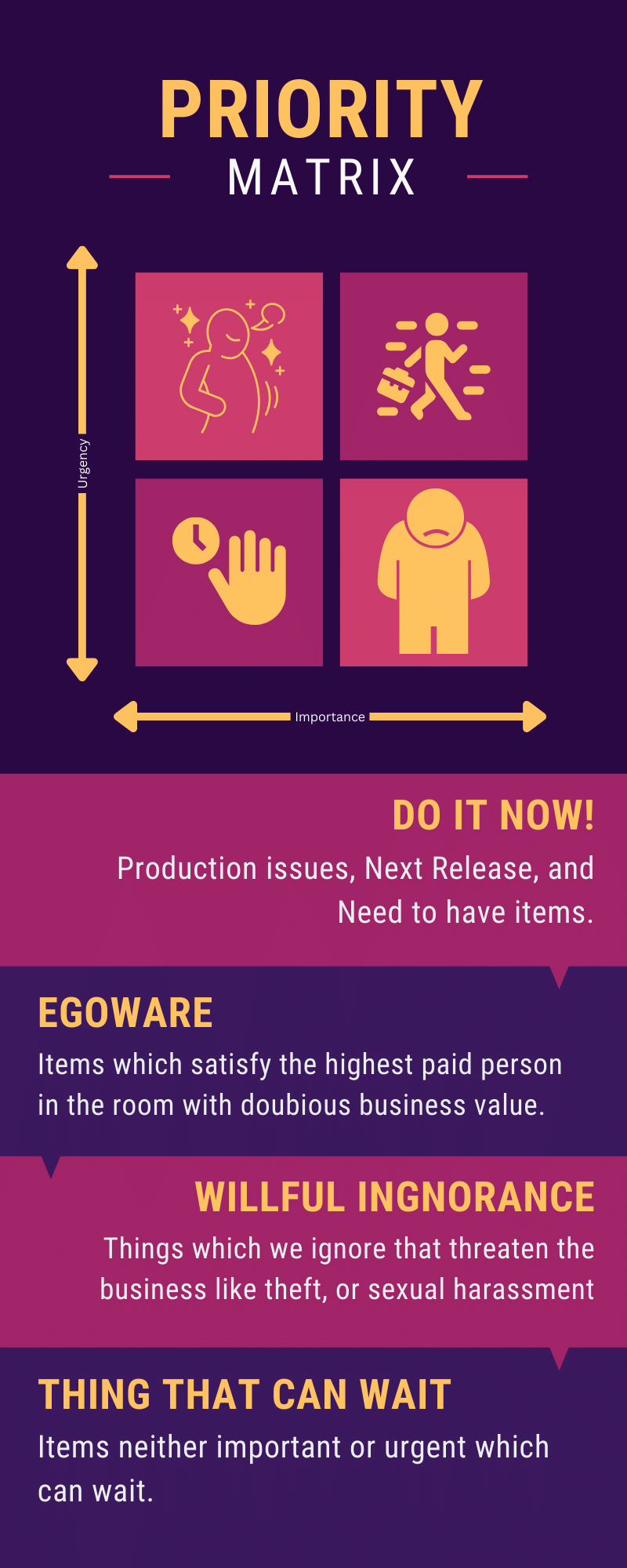Helpful tips setting priorities.

Being a white-collar professional is a mixed bag. With a few clicks of a mouse or the stroke of a pen, construction projects begin, or new markets are born. They also suffer through bad coffee, office politics, and people who enjoy humiliating others. It is a load of responsibility without much authority and being separated from your family to provide them with opportunities you never had. As a professional, it amazes me to see who rises through the corporate food chain and who flounders. It feels like the worst moments of high school when you thought you were not intelligent, cool, or pretty enough to matter to anyone else. Those who rise to the top often depend on the invisible people to manage their businesses and keep the global economy spinning. One of the most critical skills for keeping the company moving forward is prioritization, and I would like to discuss it.
In his excellent book about product ownership, Roland Pilcher discusses how every backlog needs prioritization. Over my career, I have been amazed by how many people in leadership positions have never been forced to set priorities. I blame this state of affairs on business cultures that are afraid to say “no” to executives. It creates a fantasy world where anything is possible, and the only limits are money and ego.
People who do not hear “no” often enough cannot set priorities, so it is up to others to teach them how. I have created a grid to help evaluate how to address priorities. The Y-axis is essential, with the high being very important and the low being trivial. The X-axis is the urgency of a task from mission-critical to inconsequential. Any work can fall onto the plane, and based on where it lands determines how you are going to take action.

Mission Critical and Important -
Anything that threatens the business's survival or costs money falls in this category. Consider it like the e-commerce site is down or your boat in the middle of the ocean is sinking. You need to stop what you are doing and address it now.
Less Critical but Important -
These are things which will improve the business and increase profits. It could be an update to the company website with full social media integration. It might be the addition of a more powerful engine to your fishing boat. Whatever the issue, speed to market means you should do it before your competitors do.
Need to have Items -
Items that are less critical than the things above and that are not time-sensitive need to have issues. These items generate profit but can be scheduled based on budget or staffing priorities.
Nice to have Items -
When something is neither trivial nor essential, it is known as a nice-to-have priority. Things like changing a website's color scheme or streamlining an ordering process fall into this category. Schedule these tasks when time allows.
Egoware -
In large organizations, some people have tremendous authority and the self-esteem to match. These individuals look at priorities that may not be essential and give them urgency. Often, it is to satisfy personal preferences rather than business needs. In the software business, we call this kind of development Egoware. Any organization that fulfills the construction of egoware is toxic, and executives, scrum masters, and coaches should work to eliminate it from the organization; otherwise, egoware will choke out the more important work at the firm.
Willful Ignorance -
The organization is often blind to these issues, which are essential but treated as inconsequential. For example, a top salesperson uses his expense account to cover gambling losses. Another example is a toxic person with a history of sexual harassment stalking the office. In both cases, the organization looks the other way and treats these risks as inconsequential. Eventually, they will pay for this inattention, the problems will become more prominent, and the financial dangers will be more considerable.
Things that can wait -
If something is trivial and inconsequential, it can wait. Often, we get ideas, or the business comes up with suggestions. They can linger for another day if they are not urgent or essential. These items sit at the bottom of the backlog or project plan. If something can wait, it should have a “shelf life.” It should be reviewed after sitting on the “to-do" list for a certain amount of time. If the idea can deliver value, it should be moved to the nice to have priority. It should be scrapped to make room for other ideas if it does not.
The famous business consultant Peter Drucker said, “First things first, last things never.” From this chart, it should be easy to determine what matters and what can wait. You can spot things that are dangerous or dysfunctional to the firm. Following this approach will make you more competent than many executives at big companies.
Until next time.




Comments ()